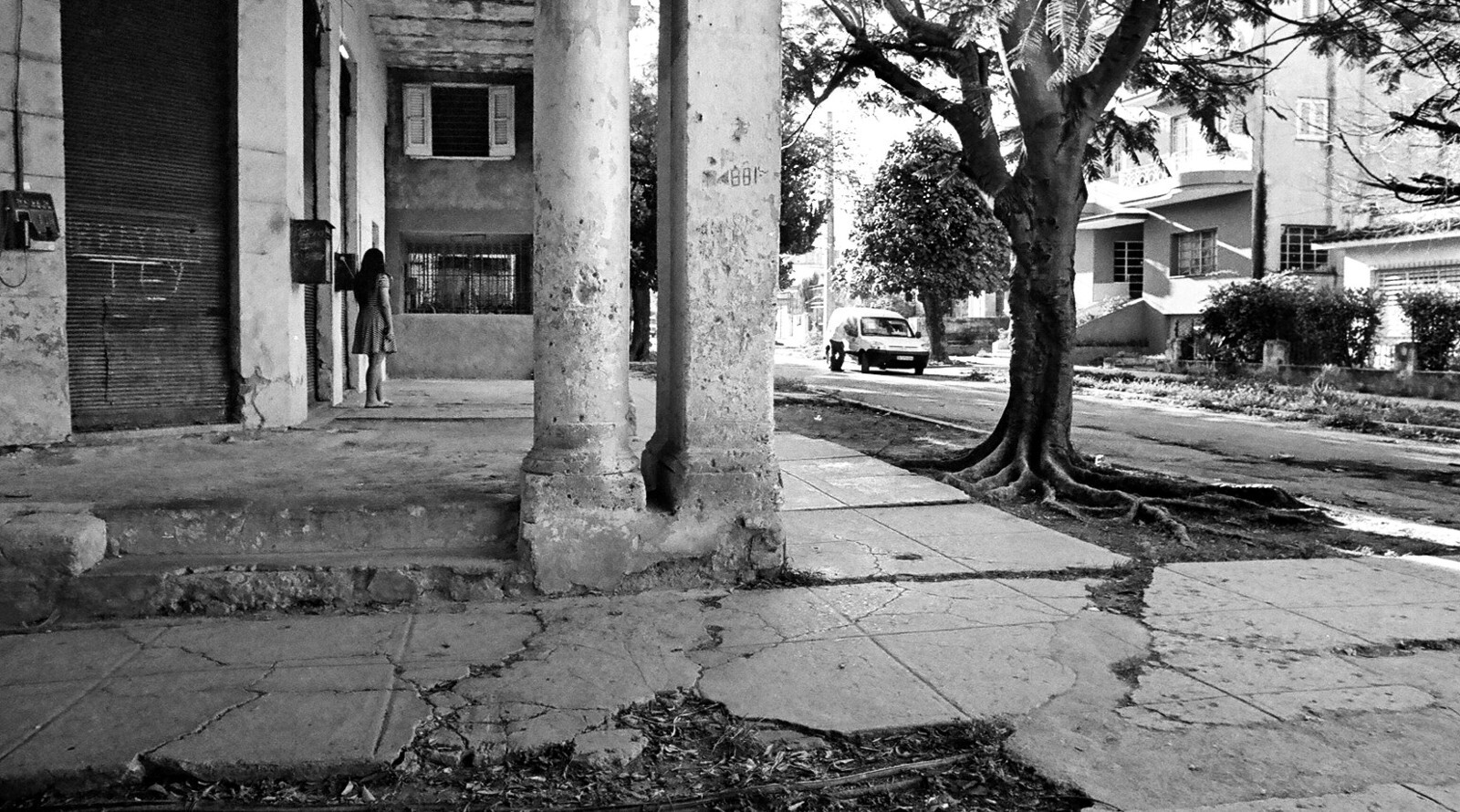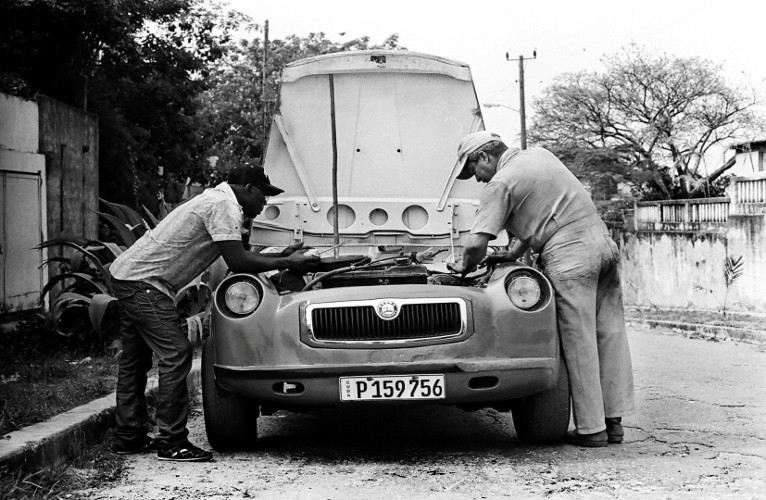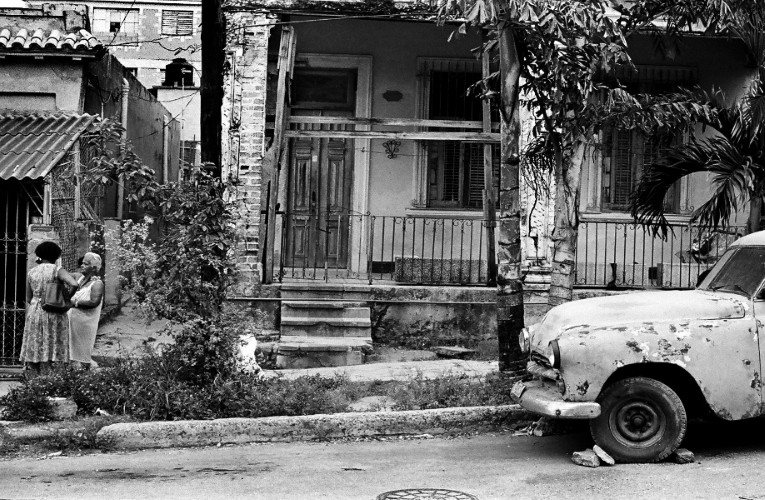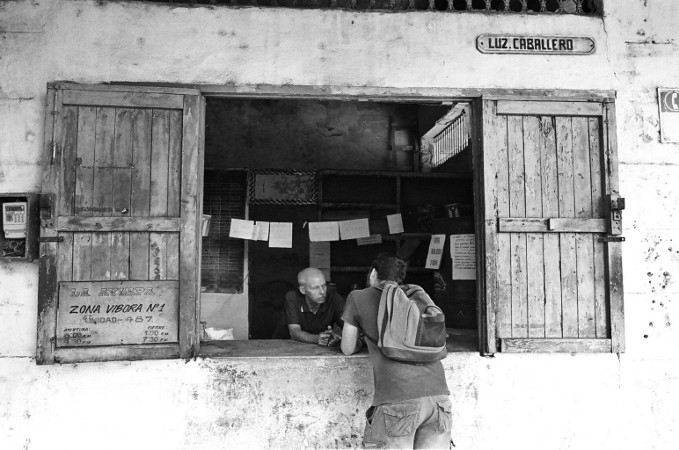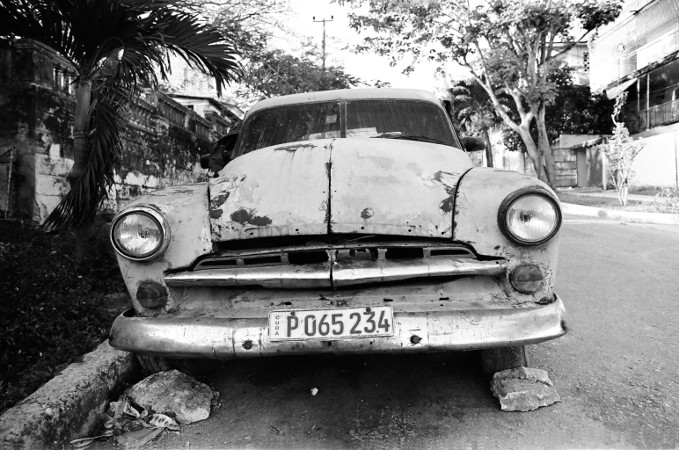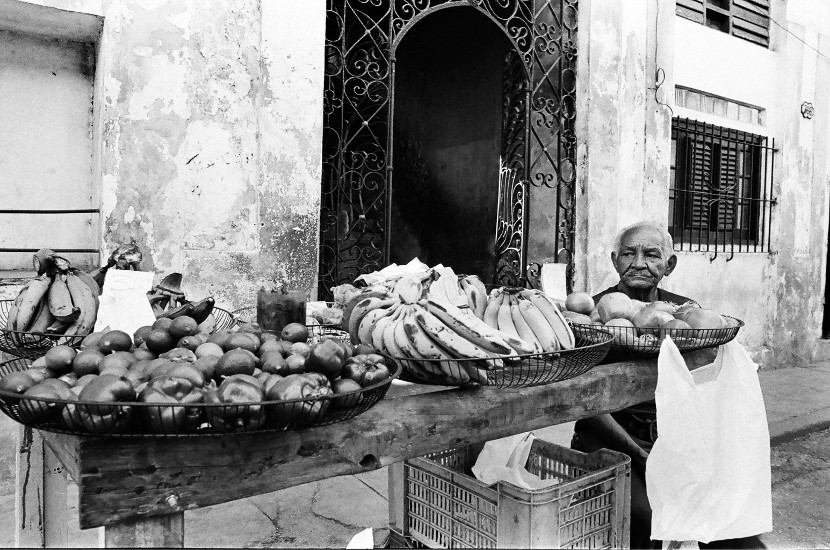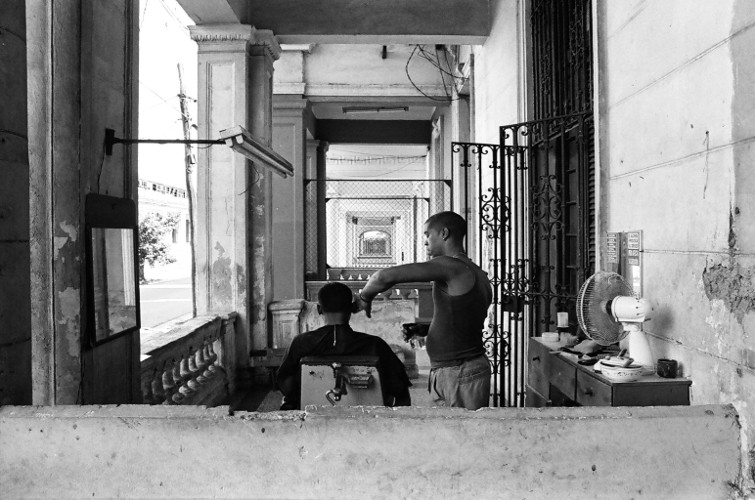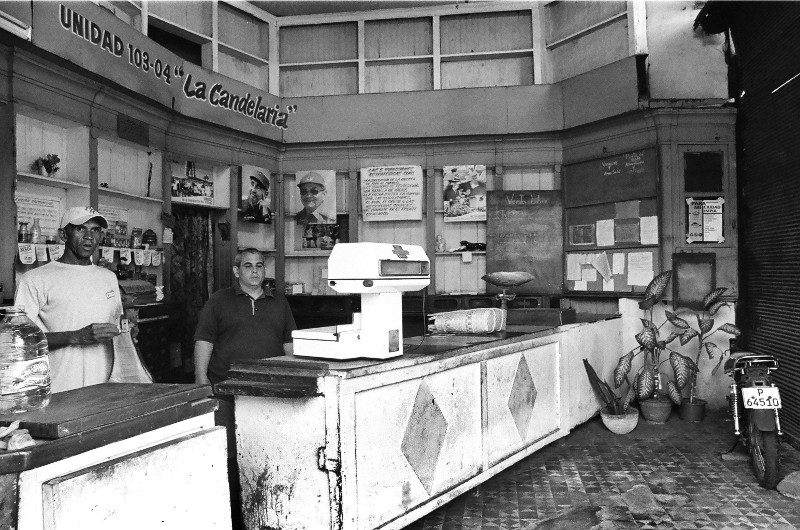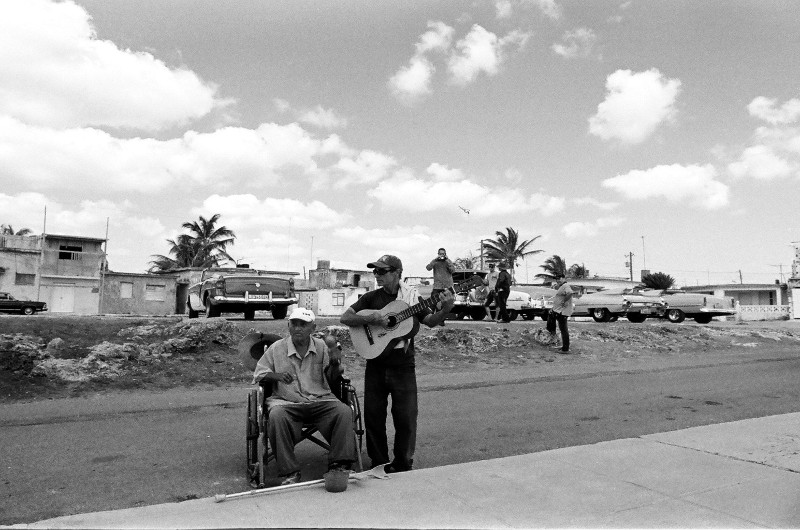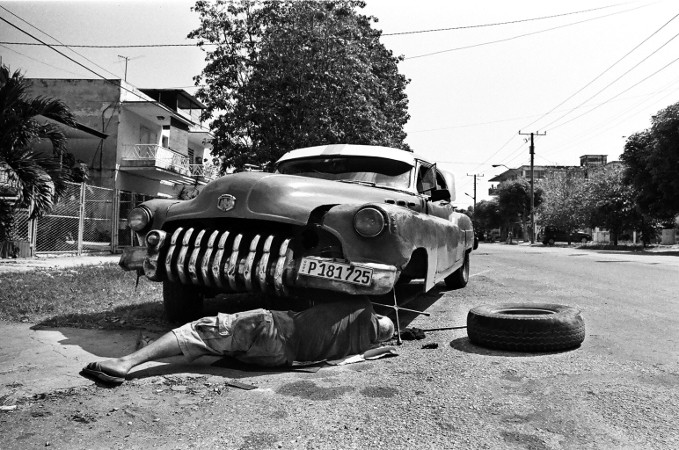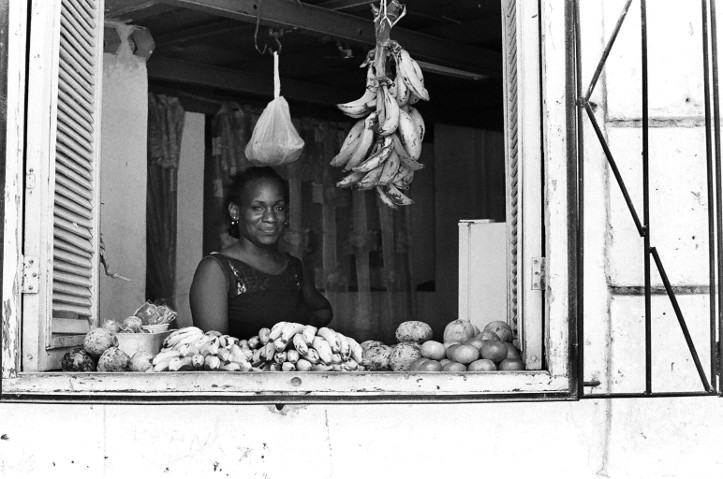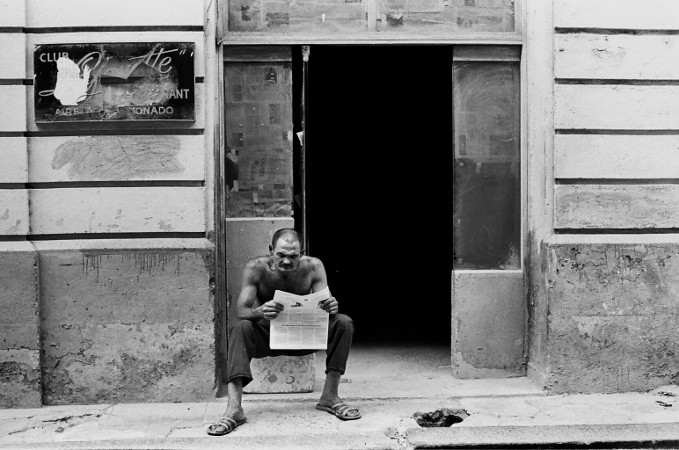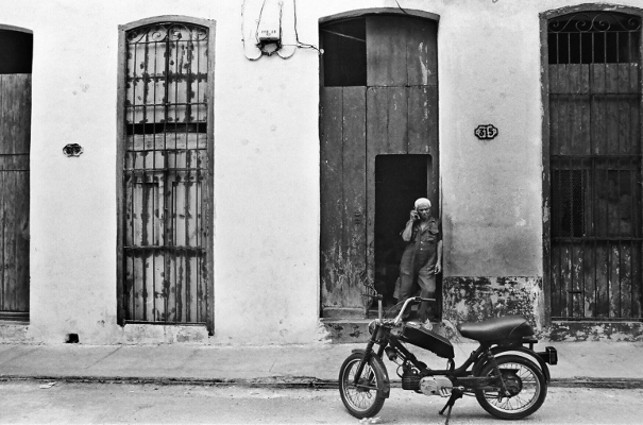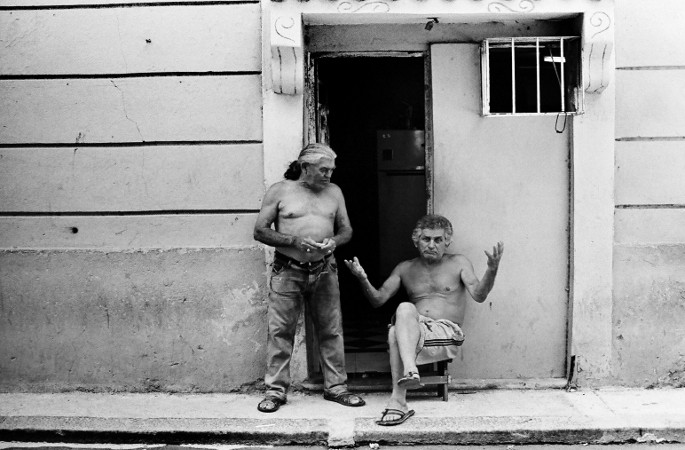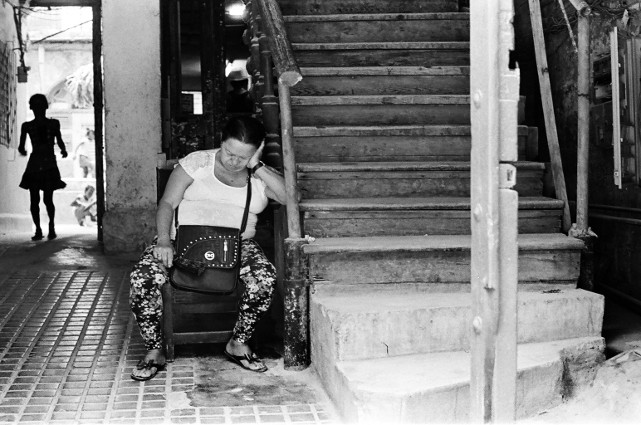Adventure at the Airport
Travellers to Cuba can ‘buy’ a tourist card at the airline counter at the Mexico airport – confirmed multiple times by the Cuban Embassy in Delhi and by our airline Aeroméxico; we were told its an easy 5 minute purchase at the airport, ‘it is no problem’. But problem it certainly was: on reaching the airline counter at 7:30 AM in early April 2016, we were refused permission to board. Our Cuban adventure had started in right earnest, way before we were really ready for it.
He could do nothing, the taciturn Mexican used to irate customers shrugged, pointing to a short list of banned countries pinned on his notice board. Airport purchase of Cuban tourist cards by these nationalities had just this week been banned through a Cuban government regulation that put Indian, Pakistani, Bangladeshi, Iranian, all African nationals. We had to appear for a personal interview at the Cuban embassy in the city for a visa if we wanted to board the flight; these were his instructions. ‘Sorry, Señor …. Next, please.’ Brick wall.
We were momentarily overwhelmed but my Indian disaster management genes kicked in, and off we went to pull back our checked-in luggage via our connecting flight, figure out how and when to reach the Cuban Embassy in Mexico city to apply for a visa, and then catch a flight to Habana the same evening. We couldn’t, however, save our ticket; our 10 AM flight to Havana had left, we were a ‘no-show’. On reaching the Cuban Embassy, a real surly gatekeeper told us we couldn’t go in with our bags, which we left with an Iranian girl from Canada who was in the same boat … umm … airplane. This rude man was a taste of good old socialist bureaucracy, with malice towards all, waiting for an opportunity to bang the heavy iron gate on the world’s face as he had a job (which most of his countrymen don’t) which he clearly disliked, and wanted the visiting world to know it. We see these kinds all over India, so it wasn’t really that much of a surprise but to face it in Mexico was. We went in to submit an application, and were queried by a young Cuban visa counselor in a deeply smoked room (communists, it seems, don’t die of smoking in closed spaces) …. why were we going? (huh?) Where were we staying? (‘this is a private home …hmmm’) We were husband and wife? While I could see he wanted to make sure we were bona fide tourists, I later wondered how many like us would want to enter Cuba illegally, and for what purpose? Without being in Cuba yet, we could sense (we thought) what was to come. We were wrong.
We reached Havana at 10 pm, and couldn’t have chosen a worse time to reach the grimiest airport I can recollect. It was a darker, more sullen, and grimmer version of a 1970 Delhi airport; and we were subjected to special immigration questions as Indians. The other tourists seemed, to my jaundiced and suspicious eye, huddled together, whispering, conspiring in the poorly lit hall against the darkness outside; without any of the light heartedness and temporary mindlessness that tourists usually exhibit. The airport staff was depressingly government, specially the unreal women staff who were lounging around in faux army khaki short skirts with black stockings - communist gogo girls - we couldn’t figured out what they did as they strolled the corridors. The baggage belt moved by at a snail’s pace, with true creaking sound effects – without bags, though – for a mindless 30 minutes. Don’t be in a hurry, we were told by a lounging airport employee, it will take lots of time to come. It finally came, and then we thought of standing in line to exchange our Euros, and immediately changed our mind when we saw the long queue of harried, tired tourists. This would all have been kind of amusing if we both weren’t hassled with 18 hours of travel and surprises, though it’s a great story today. We escaped for our bed and breakfast, La Rosa de Ortega, on the outskirts of Havana; in the first of many taxis and a taxi driver with … ahem … character.
The Telecom Tyranny
La Rosa is a quaint bed & breakfast in La Vibora, a quiet residential suburb of Havana that we had identified and paid for with persistent effort. We had faced multiple challenges: private boutique B&Bs - the intimate and local kind Rabab and I like to stay in, as opposed to a hotel - don’t yet exist in Cuba, and banks don’t accept transfers to Cuba. We strolled from La Rosa to the local market in Monaco on a hot, sunny and humid late morning, our first soaking-in of the jaded neighborhoods, the kaleidoscope of colors of homes, cars and people, the run down stores. We changed Euros to the Cuban Convertible Peso ‘CUC’ in a near 1:1 ratio. Pronounced ‘kook’, this artificial currency is a product of a controlled economy - 1 CUC gives 24 of the local Cuban Peso (CUP), which can be but aren’t used by tourists and are not tender in the places tourists frequent; and if you have Dollars to change, these are sold at a 10% ‘discount’. Got it? Rules that are standard in the capitalist world today are different here, very uniquely Cuban. Are these not required? Not quite so sure, seeing that the ‘free’ exchange rate market that India has embraced has dropped the rupee from a 43 to a Dollar in 2011 to 70 today.
Cuba is a small country of 12 million people, 65% of greater Delhi; its importance comes not from its size but from its David status as a (barely) surviving Communist nation just 90 miles away from the mighty Goliath of the USA. The Cuban Communist Party controls the publicly-owned economy, as well as almost every aspect of society, very tightly; in contrast to the so-called ‘free’ capitalist economies where large corporations from rich countries define the rules overseen by capital-friendly governments. The urban infrastructure we witnessed is in poor shape - roads, cars, buses, trains, housing, urban waste disposal and sewage, shops, telecom. But this is a political and ideological problem too as the American economic embargo since 1962 has played its intended part in impoverishing Cuba, compounded by the misplaced policies of the Cuban state.
While many aspects of the economy and of society have seen an easing of these controls in the last 5 years, Cuba is in the very early stages of what is clearly a wrenching transition to a new world where there are many more questions than answers. Cubans are in a very difficult situation – they need to chart their transition path to capitalism both quickly and carefully to meet the aspirations of a restive population, to not lose the benefits of their Communist heritage and not give in to the unreasonable demands of capital. A tough job for any society in the best of times, Cuba’s rulers have an almost impossible task ahead of them.
Till very recently, there was no public Internet in Cuba (I’m not sure it was entirely a bad thing). Now that it is allowed, it’s was a tragicomedy to access it. On our first day in Havana, we stood for 30 minutes in a queue at the Cubacel (the government mobile phone company, and the only one in Cuba) - the line was snaking its way slowly, and became frozen when an armored police car stopped and machine gunned soldiers entered the shop - most probably for picking up the receipts. Everyone looked quite resigned to waiting long hours in long queues; I wasn’t. The ingenuity of common people when faced by the dead weight of the State is amazing the world over, as we soon found out. I got talking to a young man on the street who was speaking broken English – unusual, as everyone understands only Spanish - who pulled me to the restaurant opposite and within 10 minutes gave me a SIM (ingeniously, from the cell phone of a steward there who obviously knew the folks at the Cubacel office across) and I was up and working for 60 Euros.
The telecom adventure wasn’t yet fully done, for to connect to the Internet we had to walk to nearest ‘Wifi point’ at hotel Altos Mundos, and finally accessed my email. The network connected, dropping and slow, but it felt secure to be connected by phone and internet. Our Indian phones were naturally not working. Nothing earth shattering had taken place in the 36 hours since I had accessed my email, just goes to show how the smartphone has got us by the short and curly. We have to be connected 24x7, we have to be upset at the poor connection, even though the information we access most probably has no value. In Cuba, though, having a cell phone and internet was a required security blanket.
Culture
We had lunch at Plaza de la Armes, along with our first of many taste of the sounds of Cuban music. Undoubtedly, music makes Cuba unique, even when the musicians play popular La Bamba kind of numbers on tourist requests. We were entertained by only-women bands, traditional music bands, new Cuban music bands - each of which were simply amazing. It is easy, however, to visualize how Havana could soon become a tourist trap destination like so many other once ‘undiscovered’ places that cater to the tastes of millions of middle class Americans and Europeans.
Despite the desperate straits Cuba is in, we were pleasantly surprised to see flamenco dance by visiting artistes from Spain, modern dance by Cuban young men and women; some stimulating museums: Belles Artes, Ceramic, and Colonial Art; some great Ballet at the well appointed Gran Theatre including 53 minutes of Carmen; and even a forgettable evening concert (young talent playing an average piano and a bad soprano) at the Basilico de San Francisco de Asis hosted by an European embassy. We had dinner at the busy Mercaderes restaurant, sitting on the balcony overlooking a pedestrian street of the same name with live Western classical music from the adjoining balcony. All these were fleeting glimpses of a distant Europe, in a run down Cuban setting. It was so incomplete and bizarrely mislocated, and that it exactly why it remains so memorable.
Meals at almost all the restaurants were a sorry copy of a European one; the chef had clearly forgotten some critical elements while following the form. Neither were all the ingredients there, nor were the vegetables fresh or tasty. The contrast with a vibrant traditional and contemporary food scene in México, where we had spent 12 days before Cuba, was striking. In fact, being a vegetarian in Cuba is a serious challenge, to put it mildly, seeing how dead pigs and cows are the main meals. I had avidly read about how Cuba was all-organic grower as an unintended by product of the American economic blockade and the resultant absence of fertilisers, but it didn’t quite look or taste like that at all; the range of vegetables available in the streets of Havana and in its restaurants was extremely limited. Our host at La Rosa is an outspoken Cuban lady, and she was quite emphatic that Cubans have forgotten their wonderful food heritage – for example, cumin had been off the bare shelves for so long that people have forgotten how it was a key ingredient of traditional dishes till the Sixties. We had the best meals of our stay at her kitchen – frijoles negros con Arroz (kidney beans with white rice), fresh salad and spaghetti pomodoro.
In the upscale Vedado residential area of Havana, with stately embassies and grand homes of bureaucrats, we dined one night at the Atelier rooftop restaurant; our best meal outside La Rosa. This is one of the few that have opened up due to pioneering private entrepreneurship wiling to run the gauntlet of both the state and the limitations of an emerging private market, but there will surely be many more as tourism demand by the discerning tourists grows and state controls wither.
Quite surprisingly, seeing how impoverished the country is, at almost all of the restaurants in the city our meals often cost $40 – specially unusual for a country where a doctor earns $15 a month. We did not spy a single Cuban at any of these restaurants frequented by tourists; they simply cannot afford these prices. There is actually much more visible inequality in India, where a five star hotel meal costs upwards of $100 for two when most Indians earn less than $75 in a month; what is unique in Cuba are the universally and state mandated low wages. The Communist Cuban state forces everyone to live on the edge in desperate straits of reasonably equal poverty, while the Capitalist Indian state enables the rich flourish and establish vast social disparities. There is much learning for both, but we know which model is winning the world over.
Basic food items – rice, sugar, oil, eggs - were scarce and rationed at 20% of the market rate. Government stores had the proverbial one product on the shelves, with 95% of shelf space empty. The lines to buy what little was available were always long and winding; though there is food at the end of the rainbow. As an Indian and as an avid supporter of state run ration shops for the desperately poor, I appreciate how beneficial food security is to the underprivileged especially in villages and urban slums, and I was not as surprised or disparaging of this as visitors from the West often are.
While Havana was visibly deprived we did not see hungry, starving children or adults anywhere. On the contrary, most were slim and looked fit. Clearly, the state ration stores do a bad job of choice and quantity and a reasonable job providing the basics of nutrition. Cubans mostly eat at home as they cannot afford to eat out, and one by-product of this situation is that there are no American-style fast food restaurant chains with junk food that are the cause of the modern, lifestyle-diseases epidemic the world over. Strangely, therefore, poverty may actually enhance the life span of this generation of Cubans if not the next. I can only hope Cuba allows many restrictions to be removed, but not on MacDonald’s, KFC, Pizza Hut and their many American cousins.
A young, personable, qualified lawyer who works to bring joint venture companies into Cuba works as a steward as he earns three times serving tables than being a $15 a month lawyer. An English teacher at a government school teaches the language privately to people eager to learn English on the side, and now also conducts tours for tourists (like us) and takes us around in the broken down car driven by her sweet Spanish-speaking husband. The young Marol is a trained and practicing Chef who speaks a bit of English and takes tourists around too, and his 60-year father drives their fume-spewing and coveted car. Everyone seems to hold down two-three part time jobs, working hard to make ends meet. We held long conversations with people who just wants jobs, are increasingly outspoken and sick of a life of deprivation. There are simply no private sector jobs to be had outside tourism, however deleterious it could be for an independent future of the country.
Some of the old Havana hotels like Hotel Nacional, state owned since 1959, are grand, atmospheric and decaying; it is like the grand Mumbai Taj Mahal hotel run for 50 years by the management of Delhi Gymkhana Club. You get my drift.
We drove to the sleepy Cojimar village on the beach, where Hemingway once lived. Cuban official history likes to showcase this American literary icon as Fidel Castro’s amigo, proof that that not all Americans disliked Cuba and its revolition. We reached early, before the buses and Oldsmobile’s of teeming tourists descended, and listened to some really nice Spanish guitar singing by a twosome by the water. There was, obviously, a local Hemingway restaurant with the compulsory Cuban singers serenading. We closed the evening out by chugging along slowly to the beautiful turquoise waters of the Playa de Estes beachfront where only locals hang out.
We visited the Museo de la Revolucion, once the Presidential Palace (decorated in the 1920s by Tiffany & Co of New York, no less) representative of the unequal society before Fidel, Che, Cienfuegos and their comrades overturned that comfortable and exploitative world in 1959. A memorial to such a seminal social & political event is absolutely a must, but just not in the way it is done. The whole place is falling apart, the displays are terribly done, the photographs were unrecognizable, the text and the display were worse, and it was propaganda without any pretense of presenting a version of history. Totalitarian states don’t have to worry about such niceties, as they have no one to convince. A simply terrible version of our own National Museum in Delhi gone to seed.
Homes & neighborhoods
Cuban law has allowed home ownership by individuals only as recently in 2012, since Raul Castro commenced a limited rapprochement with capitalism. Even for those lucky few who somehow collect the money by selling their old home and remittances from the relatives living in the USA – over a million - the market mechanism for private sale and purchase is very nascent. In addition, citizens need to work through a labyrinth of state regulations and forms to execute their purchase. What is more of a problem to most is the unaffordability - how do you buy a home when it costs 1,000 to 3,000 times your annual wages of $250 (Rupees 38,000)? Yes, a small apartment costs between $30,000-70,000 (Rupees 20-50 Lakhs). Most couples stay on with their parents or their in-laws, often constructing a new home in the yard of the older generations home; an unusual and most probably a forced joint family.
I don’t photograph on family vacations; however, being in Cuba meant I had carried my small Olympus 35 mm film SLR. The afternoons were hot and humid, and I took this time to walk the streets while Rabab took shelter at La Rosa. Used to worse squalor in Indian towns and cities, it was an unexpected shock to see the level of disrepair, poverty and evident human despair. All the apartment blocks were decrepit, with hordes of unemployed residents hanging out. It became clear that just the core tourist center of Vieja Havana had been spruced up, and there are no funds for these regular apartments; not with the individuals, not with the state. A few were being restored or renovated due, I was told, to remittances from rich American Cubans. I was shown one that an Italian had bought and restored for $250,000 – a Roma villa, surreally virginal white and out of place in a neighborhood of grey. It seems his Cuban wife enables him buy property, who ‘will soon leave him and claim the property. This is what some Cuban women are doing’. A potential model for escaping hopelessness, for the not so innocent.
Healthcare & Education: A Cuban Success Story?
Cuba’s supporters, whose dislike for America and its foreign policy overwhelms the reality of a dysfunctional Cuban economy and political system, admire Cuba’s free and universal healthcare and education system. We heard this proudly from Cubans, though we were not able to experience either first hand. What we did see is that all children and adults, no matter how dilapidated their homes, looked healthy and fit.
All healthcare, hospitalization, surgery, medicines are free for all citizens and all medical institutions are Government owned; education is all state funded (no private or Catholic schools) free and universal with a 100% literacy rate and a well developed multiple tier system funded at one time by 34% of the government’s budget – today, it is supposedly 7% of Cuba’s GDP, one of the highest in the world. These models have elements that the world can learn from, certainly in India where the state has receded from both education and healthcare in the face of an aggressive private sector targeted to a miniscule minority who can afford to pay.
“So the scene was set for Fidel Castro to select education as a major issue for his revolution. He had mentioned plans to raise teachers’ salaries and improve rural schools briefly in the manifesto of his revolution, but once in power it was clear that he saw education as having a pivotal role in consolidating his revolution. Under Fidel Castro, education became universal—but he also stipulated that anyone who received this education would have to actively promote government policies both during and after their schooling. They would also be required to take government-approved courses that didn’t tolerate any criticism of socialism as a way of life. In other words, education was seen as key to the revolution taking hold and creating a literate population loyal to the government.”
“The record of Cuban education is outstanding: universal school enrollment and attendance; nearly universal adult literacy; proportional female representation at all levels, including higher education; a strong scientific training base, particularly in chemistry and medicine; consistent pedagogical quality across widely dispersed classrooms; equality of basic educational opportunity, even in impoverished areas, both rural and urban. In a recent regional study of Latin America and the Caribbean, Cuba ranked first in math and science achievement,' at all grade levels, among both males and females. In many ways, Cuba's schools are the equals of schools in OECD countries, despite the fact that Cuba's economy is that of a developing country.
The government allowed Cubans to travel abroad in 2012 Till then, there was a blanket ban on overseas travel with travellers requiring an exit visa – Cuba was one giant jail, a marker of a totalitarian state. Applying for a US visa costs mucho dollars, and visa rejections rates are high as everyone is a potential immigrant. Most cannot afford air tickets, so the unofficial and illegal migration by boat to Florida remains alive due to the 1966 US law and policy of allowing asylum to all Cubans who land on US soil.
Race and Cars
Not surprisingly for a Communist nation, we saw no visible signs of organised religion. Not an altogether bad thing, seeing how Christianity played havoc since the 16th Century with the indigenous peoples the world over in its alliance with European feudal and colonial powers. The people were a kaleidoscope of colors – yet dominated by ‘white’ (64%), though mestizo (mixed) 26%, and blacks (10%) are a significant minority, though some says most Cubans are by now mixed. What is clear is the indigenous people have disappeared in the mix.
“The private sector in Cuba now enjoys a certain degree of economic liberation, but blacks are not well positioned to take advantage of it. We inherited more than three centuries of slavery during the Spanish colonial era. Racial exclusion continued after Cuba became independent in 1902, and a half century of revolution since 1959 has been unable to overcome it.”
Cars are old not because of a plan to keep the country atmospheric for tourists, but simply because Cuba has been stuck in 1959 (the year of the Revolution) and individuals did not have the approval to buy cars and neither did the US embargo from 1962 allow imports. These cars are family heirlooms as well as a source of livelihood for those few who own one - a running car can sell as much as for $20,000 – but are in a bad shape (even by lax Indian standards) and spew smoke in clouds not seen in our fair subcontinent. Ford, Buick, Chevrolet, Plymouth; of course the Lada and Volga from Russia – with Peugeot diesel engines, or in fact any engine cobbled together to somehow run the tired wheels. At close examination, few of the cars have anything of the original other than parts of the outer body. For the car collector, these are a questionable value.
“The time-warp feel to the place stems from the imposition of the U.S. embargo in 1962, during which American companies were no longer permitted to do any business in Cuba. Once in place, it was not possible to get new American cars or parts. Fidel Castro's autocratic socialism was the final nail in the coffin of the new car market—Cubans weren't permitted to buy cars. They could only be given them by the government. And the government never had enough money to import cars en masse from Europe or Asia. During the Soviet era, Russia sent Ladas, which, despite being newer, didn't last as long as the American cars.”
The cars are a representation for Cube. Like Cuba, the cars look exotic, atmospheric and like the real thing when viewed cursorily, from a distance. The closer you look, however, and the deeper you dig below the surface, you realize the beauty is skin deep and it had all actually fallen apart, and is just stuck together with whatever, anything that became available. Cuba is between epochal periods and between systems, not knowing which way to turn even if the creaking steering wheel does. Fidel and Communism are clearly on their last legs and American style consumerism will surely arrive – tourists by the boatloads (the first huge American cruise ship had docked in Havana that week), tourism Cancun style where expat Cuban capital and American partners and systems will make Cuba a more ‘authentic’ extension of Miami. It will reduce poverty in parts of Cuba, but will as surely make Cubans deskilled slaves to the tourist Dollar and Euro. Being just 90 miles from the USA, can the nation escape this blessing that easily becomes a curse. Ask the Mexicans.
Not knowing what surprises the trip to the airport would throw at us, and leaving nothing to chance, we left La Rosa to reach 3 hours before our scheduled departure. The state of the private taxi that ferried us was to be seen to be believed, as was the anxiety of my dear wife who was quite sure the exceptionally rickety taxi would not reach the airport specially after the driver breezily pointed to the non-existent roof luggage carrier when we asked where would he keep our bags in his small vehicle. The airport looked so much nicer when we were leaving, and Cuba feels like it was fun from a distance. You must go there if you can, be ready for the surprises and live to tell the story.
Postscript
Miguel Bermúdez (born 1960, a year after the Revolucion) is the heir apparent to Raul Castro, and while it is yet to be seen whether he will succeed, it will be a political earthquake when Fidel and Raul pass from the scene. Surprisingly, none we spoke to were critical of individual government servants, who they said are not corrupt; they are mostly good, dedicated people. Could this be true? The constant refrain was that the times have changed and so should the system, the Revolucion was good for its time but today we need jobs, we need money, we need to live a life of dignity, we need freedom from not having enough of anything. Will the Communists guide Cuba to embrace aggressive state-led capitalist development like China’s Communist Party has, or will they be overwhelmed by the times and disappear into history as Cuban Americans take charge? This voice – ‘the system needs to be overthrown !’ - is gathering volume, the timid reforms of Raul are feeding it, and no one knows where it will take Cuban society and the people; specially not the Communist party.
One unexpected result of my visit to Cuba was a realization that we have much to be thankful for in India. Based on a Constitution that gave us our Republic, we possess civil liberties; a (mostly untrammelled) freedom to criticize the state, laws, courts, politicians; an ability to travel freely overseas and within India; a (mostly) free media and internet where we can write what we want. Yes, these rights are more for wealthy and privileged urban Indians that constitute a minority in terribly unequal and terribly poor India, but this minority can now hear no longer mute dispossessed. The foundation of individual freedom laid in 1950 is moving us towards laying bare our inequities, and dramatically reducing them in the coming times.
I came away with renewed hope in our imperfect and unequal democracy, and with a deeper desire to help protect my rights of individual freedom, dissent, and of contributing to the construction of a more equal society. Viva una India iguales!
